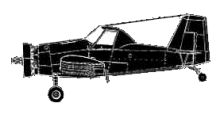
ASN Wikibase Occurrence # 296743
This information is added by users of ASN. Neither ASN nor the Flight Safety Foundation are responsible for the completeness or correctness of this information.
If you feel this information is incomplete or incorrect, you can submit corrected information.
| Date: | Thursday 22 August 2002 |
| Time: | 06:30 LT |
| Type: |  Air Tractor AT-301 |
| Owner/operator: | Spain Air |
| Registration: | N8793S |
| MSN: | AT 301-0195 |
| Total airframe hrs: | 13904 hours |
| Engine model: | Pratt & Whitney R1340 |
| Fatalities: | Fatalities: 0 / Occupants: 1 |
| Aircraft damage: | Substantial |
| Category: | Accident |
| Location: | DOS PALOS, California -
 United States of America United States of America
|
| Phase: | Unknown |
| Nature: | Agricultural |
| Departure airport: | DOS PALOS, CA (KPVT) |
| DOS PALOS, CA (KPVT) | |
| Investigating agency: | NTSB |
| Confidence Rating: |
During cruise flight the engine started to vibrate and the pilot made a forced landing in a newly plowed field and the airplane nosed over after encountering soft soil. The pilot had been crop dusting for about 7.5 hours when the event occurred. The outboard portion of one of the propeller blades had separated. A review of the airframe records indicated that the propeller was overhauled about 10 months prior to the accident. A metallurgical examination of the failed blade revealed it had failed as a result of fatigue cracking that originated from a nick, located on the flat side of the blade's leading edge. Also observed were groove marks that were relatively uniform and consistent with tool marks left by a file. In accordance with the overhaul manual, a field repair can be done to grind or file out corrosion of the blade, with a dye penetrant inspection to detect any visible damage or cracks (Hamilton Standard 130B Blade Overhaul Manual). The overhaul manual notes that tool and file marks should be polished out as one of the final steps in the process. According to the FAA approved flight manual, during the preflight walk-around inspection, the pilot is to inspect the propeller blades for nicks and cracks.
Probable Cause: the failure of the propeller blade due to fatigue. Factors in the accident were the inadequate maintenance-repair of the blade, and, inadequate pilot preflight inspections.
Accident investigation:
 |
|
Sources:
NTSB LAX02LA257
Revision history:
| Date/time | Contributor | Updates |
|---|---|---|
| 14-Oct-2022 10:14 | ASN Update Bot | Added |
Corrections or additions? ... Edit this accident description
The Aviation Safety Network is an exclusive service provided by:


 ©2024 Flight Safety Foundation
©2024 Flight Safety Foundation